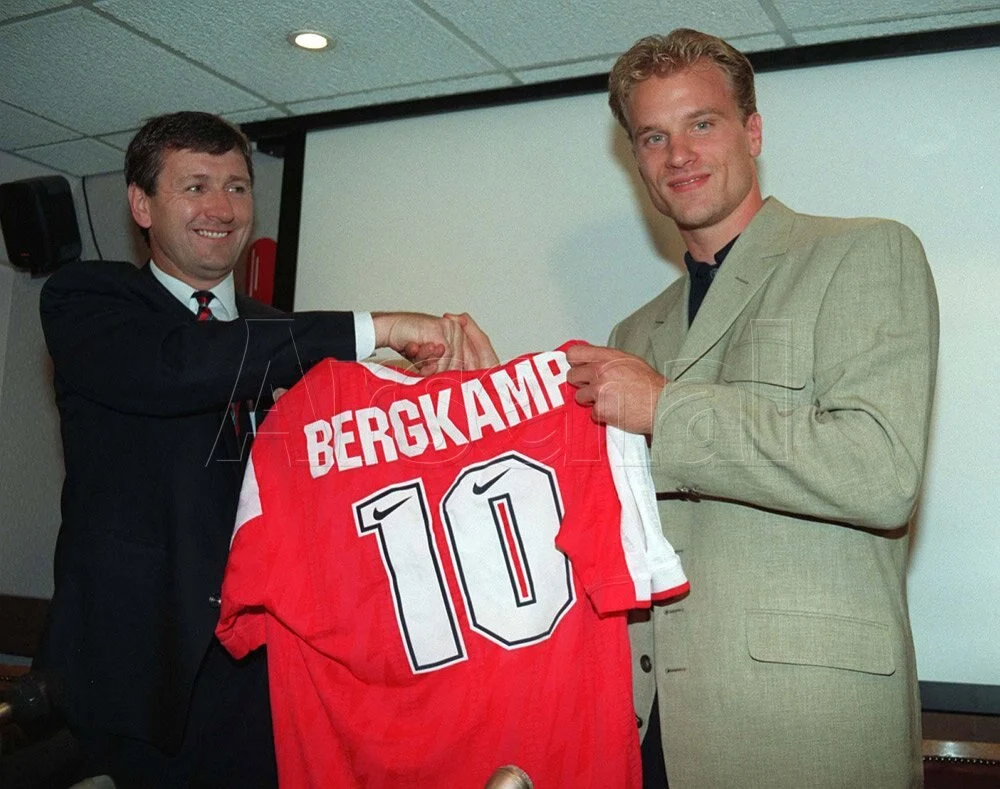Flying terrified him. Defenders feared him. And yet, despite never boarding a plane in his Arsenal years, Dennis Bergkamp carved out one of the most magical careers football has ever seen.
He was the maestro who could kill a ball out of the sky as if it were made of silk. A player who turned Highbury into his personal theatre. But off the pitch, there was another story—one that earned him a nickname just as legendary as his football: The Non-Flying Dutchman.
This is the story of how phobia, tragedy, and sheer stubbornness shaped one of the greatest players to ever grace the game.
Why is Dennis Bergkamp called The Non-Flying Dutchman?
Most players get nicknames because of their flair, their goals, or maybe even their hairstyle. Bergkamp got his because of his refusal to step on a plane. But the roots of that decision run deeper than simple nerves.
A tragedy that scarred Dutch football

In 1989, when Bergkamp was still a young Ajax player, a flight carrying the “Colourful XI” crashed in Paramaribo, Suriname. Among the 176 victims were Lloyd Doesburg—Bergkamp’s Ajax teammate and Virgall Joemankhan, one of his academy friends.

Bergkamp wasn’t on that flight, but the shock cut deep. Even though he continued flying for years after, he admitted later that he never felt comfortable in the air again.
Fear turns to phobia
By the early ’90s, Bergkamp’s nerves had grown into full-blown aviophobia. This wasn’t the standard “butterflies before take-off.” He would sweat, shake, and spiral into panic even before boarding.
And then came the 1994 World Cup in the USA—the final straw.
The Breaking Point: USA 1994
Bergkamp went into the tournament as one of the Netherlands’ brightest stars. But his flights there became a nightmare.
- A failing engine: During one flight, the Dutch squad experienced engine trouble mid-air. Panic swept through the cabin. Though the plane landed safely, the incident left Bergkamp shaken.
- A cruel joke: On another flight, a journalist made a joke about having a bomb in his bag. The flight was delayed, and the man was arrested. For Bergkamp, already on edge, this was confirmation that flying was hell.
He played brilliantly at the tournament, scoring goals and shining for the Oranje, but he admitted his mind was often distracted—not by defenders, but by the thought of the next plane ride.
By the time he joined Arsenal in 1995, Bergkamp had decided: he would never fly again.
Arsenal Accepts the Non-Flying Dutchman

When Arsenal negotiated with Inter Milan for Bergkamp’s transfer, they knew they weren’t just buying a player—they were buying a unique case.
Bergkamp told the club straight up: he wouldn’t fly. No Champions League away games in far corners of Europe, no long-haul preseason tours.
Arsenal accepted it, though not without a cost. Bergkamp himself admitted that his contract included deductions of around £100,000 because of his refusal to fly. “If I said a million, they automatically deducted a hundred grand ‘because you don’t fly’,” he revealed in his autobiography.
Still, the Gunners had no regrets. He gave them moments so divine that no plane ticket in the world could compare.
Life on the Ground
So how did Bergkamp manage European trips when Arsenal couldn’t avoid flying?
He travelled by train or car whenever possible. Sometimes he simply stayed home. That meant Arsenal often had to tackle huge Champions League nights without their magician. Fans still debate what might have been had Bergkamp been present for some of those away defeats.
But Bergkamp never wavered. He once said:
“I know what flying is. I’ve flown countless times in large planes, small ones, tiny ones. And I’m simply not flying again. Ever.”
It wasn’t stubbornness. It was trauma.
Inside the Mind of Dennis Bergkamp: The Non-Flying Dutchman
Bergkamp rarely spoke about his phobia. But when he did, it was chilling.
He described how small, shaky planes at Inter Milan made him feel claustrophobic. “You just sat there shaking the entire trip. It was hell,” he wrote.
Sometimes, even during matches, he would look up at the clouds and think about the flight home. Imagine: a footballer of his genius, mid-game, worrying more about turbulence than tactics.
This wasn’t just a fear. It was something that consumed him.
Did It Define or Limit Him?
Here’s the twist: for all the matches he missed, for all the trips he skipped, Bergkamp’s reputation never suffered. If anything, the Non-Flying Dutchman nickname added to his mystique.
He was the genius you only got to see in certain places. The man who let his feet do the travelling instead of planes.
And maybe that’s why his legacy at Arsenal shines so brightly. Every moment felt rarer, more precious.
What Did Dennis Bergkamp Say About His Fear?

Bergkamp once admitted in 1996 that he considered psychiatric help. “I can’t do anything about it, it is a psychological thing, and I can’t explain it. I have not flown on a plane for two years. I just freeze. I get panicky. It starts the day before, when I can’t sleep.”
In his 2013 autobiography, he went even deeper, explaining how every shaky propeller plane at Inter added to his dread. By the end, he knew there was no turning back.
The Non-Flying Dutchman’s Legacy
If anything, his phobia only made his career more human. Bergkamp wasn’t just the magician with velvet boots—he was also the man who struggled, who had limits, who wasn’t invincible.
Yet he turned those limits into part of his legend. Arsenal fans still chant about him. His bronze statue outside the Emirates captures him mid-air, cushioning a ball as if gravity itself obeyed him. The irony is beautiful: a man who feared the skies is immortalised flying above defenders forever.
Conclusion
Dennis Bergkamp’s fear of flying didn’t stop him from reaching football’s highest peaks. If anything, it made his story richer, stranger, and more unforgettable.
The Non-Flying Dutchman wasn’t defined by what he avoided, but by what he gave us on the ground: artistry, vision, and goals that belong in galleries.
Planes may have terrified him, but football? That was his true flight.


